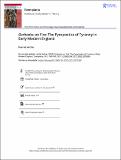Gorboduc on fire : the pyropoetics of tyranny in early modern England
Abstract
This article rereads Norton and Sackville’s Inns of Court tragedy Gorboduc (1562) in the light of its neglected preoccupation with fire. It posits the 1561 lightning strike on St Paul’s as a critical context for the play’s emphasis on fire as a motor of providential justice, through the repeated evocation of the myth of Phaethon, and locates its use of fire in performance at the intersection between political intervention and carnival festivity. Noting the play’s coevolution with the fire pamphlet genre, the article suggests that these ephemeral works’ commentary on the relationship between fire and tyranny, in line with sixteenth-century resistance theory and de casibus tragedy, illuminates how Gorboduc’s interests manifest in popular discourse, and allows an interpretation of the play’s imagining of rebellion which foregrounds the irony of its rhetoric of stability and obedience. In dialogue with recent work on the Pyrocene and European pyrophobia, and its implications in relation to Giorgio Agamben’s understanding of civil conflict and the state of exception, the article broadens the existing picture of Gorboduc’s resonance, to read it not just as pivotal in the development of English drama and political theology, but as contiguous with wider patterns of thought in premodern disaster response and narratives of collective action.
Citation
Archer , H 2022 , ' Gorboduc on fire : the pyropoetics of tyranny in early modern England ' , Exemplaria , vol. 34 , no. 2 , pp. 168-195 . https://doi.org/10.1080/10412573.2022.2070369
Publication
Exemplaria
Status
Peer reviewed
ISSN
1041-2573Type
Journal article
Description
This work was supported by the Huntington Library.Collections
Items in the St Andrews Research Repository are protected by copyright, with all rights reserved, unless otherwise indicated.

